Loyalty, Rewards, and Progress in the Digital Era
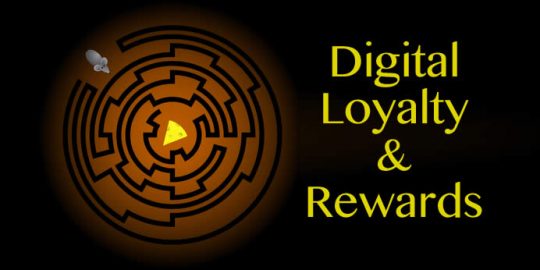
Not that long ago, my wallet contained a stack of loyalty (or, more accurately, rewards) cards. Coffee shops, restaurants, and other service businesses would either punch or stamp a paper card to count your visits. When you filled all the empty spaces, you got a reward – a free coffee, for example.
There were a lot of disadvantages to these cards, not the least of which was the need to carry a wad of cards everywhere just in case you stopped for coffee or a sandwich. They were a rather crude measure of your value as a customer, too – that punch usually had no relation to the amount you spent. And, of course, they are far from fraud-proof.
But the one area where these paper cards excelled was in providing customers with a clear measure of their progress. With a quick glance, customers could easily judge how close they were to the reward. And, that’s important, because that “distance” affects human behavior.
The Goal Gradient Effect
As I described in Loyalty Programs: Of Rats and Men, experiments with lab rats running mazes showed that the closer the rats got to a food reward, the faster they ran.
That’s fine if you have to motivate rodents, but what about humans?
A 2006 study at Columbia University used real coffee shop customers as substitutes for lab rats. This avoided PETA protests, and, more imporatantly, allowed the experimenters to measure real behavior with actual money.
The coffee shop issued customers the kind of coffee cards that we’re all familiar with. The initial condition was a ten-stamp card that, when filled, would give the customer a free coffee and food bonus.
Showing customers their progress will make your #loyalty program more effective #rewards Click To TweetJust like the rats, the human coffee drinkers “ran faster” as their cards filled up. The closer they were to filling the card, the shorter the average time between coffee purchases.
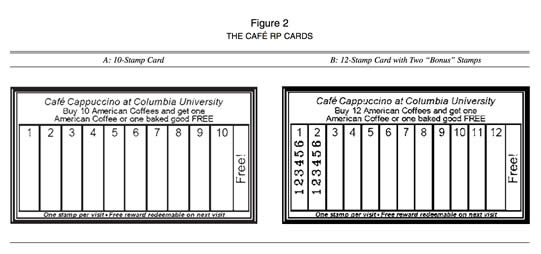
Next, they tested a 12-spot card in which the first two stamps were pre-stamped. This, of course, left ten blank spots – numerically the same as the original ten-stamp card. But, as the goal gradient hypothesis predicts, the illusion of greater progress caused even more rapid purchases.
Additional tests with a music rating website showed comparable results. As visitors got closer to reaching their goal, they stayed on the website longer and rated more songs.
Give customers some free progress in your #loyalty program, they will return faster #rewards Click To TweetPost-Punchcard Loyalty
Today, the paper-based cards have been largely supplanted by apps and CRM systems. Customer purchases are tracked digitally, and reward schemes can be far more sophisticated.
For example, Starbucks changed their rewards program to focus on dollars spent. This annoyed regular coffee drinkers who spend only a couple of dollars per visit, but customers who frequently buy food or place larger orders welcomed it.
Tracking rewards digitally also lets Starbucks offer targeted promotions, like double points for a specific product or for visiting at a particular time of day.
The problem with many digital rewards programs is that it’s harder for consumers to gauge their progress. This, in turn, makes it difficult to invoke the goal gradient effect. If you use your gold card or registered gift card at Starbucks, you won’t see your progress unless you ask for a receipt.
Starbucks does a little better job with their mobile app. Although it’s not on the “pay” screen that you scan at the register, it’s easy to see how many points you have on the “rewards” screen:
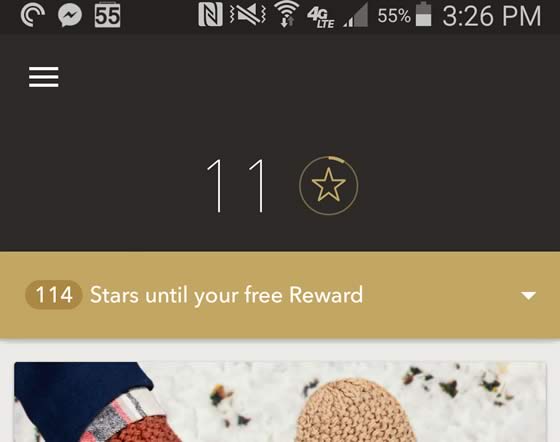
That’s not particularly visual. Estimating progress and how far away the reward is will require a mental calculation by the customer. Starbucks does provide a visual indicator of the “stars” earned by having them bounce around a cup in an animated screen. The only progress clue is the number of stars, impossible to count and difficult to estimate. A microscopic line of text notes that 125 are needed for a reward.
Still, give Starbucks credit for fully integrating payment and rewards. Many brands still require a separate action (like a card swipe or the customer providing a phone number) to award loyalty points.
Panera, also a player in the coffee space but with more extensive food offerings, takes a different approach. Their award scheme seems fairly opaque to the customer. Periodically, the customer gets notified that a reward is available – a free coffee or bakery item, for example.
There’s not a lot to be said for this apparently random reward scheme. One plus, I suppose, is the surprise factor. Research shows surprises can be good, as I described in Small Surprise, Big Mood Change. But, you lose any goal gradient effect.
In a recent promotion, though, they took the opposite tack. They ran a reward special that required only 8 visits in a defined period. No randomness in this plan – the rules and results were clear.
To make the promotion even more potent, they updated the customer’s progress with an encouraging email after every visit. This email was prompt – by the time I carried my coffee to a table and fired up my laptop, it was at the top of my inbox. (Productivity experts will no doubt suggest I employ filtering to ensure promotional emails are never at the top of my inbox!)

As I got closer to my goal, the emails emphasized how near I was to free food:
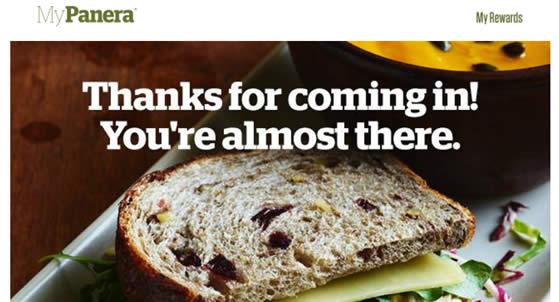
The last one was even more specific, and added prominent personalization:

I suppose some customers might find this frequent email sequence annoying, but I found it helpful in tracking my progress. And, I loved the way it exploited the goal gradient hypothesis using digital media.
Keys to Digital Loyalty and Rewards Success
The era of simple, intuitive paper rewards cards is essentially over. The good news is that digital approaches offer infinitely more flexibility in giving rewards and in displaying progress. Here are a few rules for building digitally-driven loyalty:
Keep it simple. Coffee punchcards are simple. Buy a coffee, get a punch. Fill the card, get free coffee.
Compare the simple punchcard with, say, airline rewards programs. On United, I have a revenue target that tracks how much I spend on tickets, not counting taxes and fees. I have a separate “miles flown” target, too – both goals must be met to achieve a specific status. A miles target seems simple enough. Actually, though, the miles you earn for a given set of flights depend on the class of travel and other factors. For example, a 150 mile short flight counts for 500, further confounding calculations. But wait, there’s more… you can also fly an specified number of individual flight segments instead of accruing the required miles. Got that?
United shows your progress in a reasonably clean dashboard:
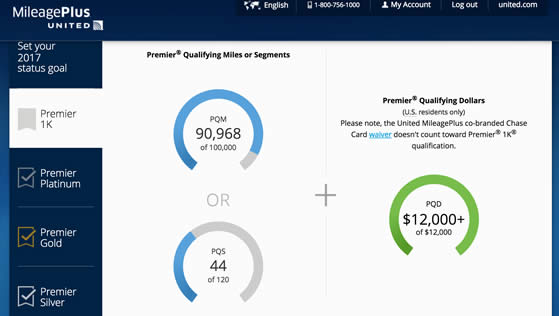
It’s fairly easy to gauge your progress to date. Unfortunately, determining what you have to do to hit the next level is far from intuitive. I use a spreadsheet to track my progress and estimate the effect of planned future travel. How many customers will do this, I wonder? Uncertainty reduces motivation.
You almost certainly don’t need or want the complexity of an airline rewards program. A good rewards system should be easy – track visits, track revenue, or some easily-understood variable like cups of coffee. When customers sees a clear path to a reward, they are more likely to pursue it.
Your #loyalty program should be simple and easy to understand. #rewards Click To TweetDisplay progress visually. To have the goal gradient effect kick in, make it easy to understand progress. Paper cards used circles with punches. Digital programs can mimic that, or use common and intuitive displays like thermometer bars.

Designers seem to like circular progress indicators like those in the United dashboard. They are fine, but my opinion is that people process a linear display more easily. If you like circles, consider showing progress as a full pie chart instead of a narrow ring around the circumference.
Start with a bonus. Nothing is more daunting than a display of little or no progress toward a goal. So, do what the Columbia scientists did – extend the goal and show the extension as completed progress. Customers will be a little more motivated to accumulate more progress.
Let customers know when they are getting closer. Customer motivation to consume increases as they approach their goal. So, let them know when they are getting close.
App notifications, email, or any other means of communication can accomplish this. Even a counter sales person can tell a customer, “You are only two visits away from a reward,” if prompted by the point of sale system.
If a particular rewards program has an expiration date, that can be an additional motivator. Letting a customer know that they are one purchase away from a reward, but there are only three days left, will add urgency to the mix.
A reminder like that might squeeze out an extra purchase or two.
Personally, I got busy preparing for a trip and missed my eighth and final purchase at Panera. (Rats! No free food for me!) A reminder or two as the deal approached expiration might have got me into the store. (Obviously, watch your analytics and don’t overdo the reminders to the point where customers unsubscribe from your list or turn off notifications.)
Remember, rewards don’t equal loyalty. Your rewards program is a great tool to build loyalty, but is in no way a substitute for a compelling customer experience. Rather, it’s a way to build a customer habit and so impress them that they feel no need to go anywhere else.
If your rewards program suddenly vanished, would your customers keep coming? If so, you have succeeded in building true loyalty.
Your turn – have you found a loyalty/rewards program that kept you coming back? Have you implemented an effective plan yourself? Share your thoughts in a comment!
Is your #rewards program building true customer #loyalty? #Neuromarketing Click To Tweet
Very interesting and clearly explained.
Thank you
I read your book, Brainfluence, and I have to say thank you to you Roger for providing a scientific explanation/defense for my exorbitant spending at Sephora. I could not rest until my mission to obtain VIB Rouge was complete, and despite buying hundreds of dollars worth of products I probably didn’t need, I still feel content and accomplished by achieving my rewards status.
I’m currently writing a blog on neuromarketing for my company’s website and Brainfluence has been a wonderful resource and source of inspiration and knowledge. Can’t wait to read The Persuasion Slide!
Katherine
Thanks for stopping by, Katherine, glad you find my stuff useful! Enjoy your abundance of Sephora!
Dear Roger,
Thanks for sharing this article. I didn’t know how important is tracking the customer progress for the rewards program.
Thanks you
Lucrecia
nice
Great write up, made a lot of sense.Thanks for sharing Roger!
Fantastic article, I cannot agree more. People love loyalty rewards, especially when they can see the progress. Plus people love free stuff, so if your business has a similar reward system and your competition doesn’t. Believe me. Customers will come to you.
Once again, great tip! Not many people understand the advantage of having a reward system.